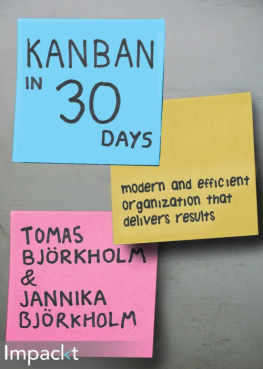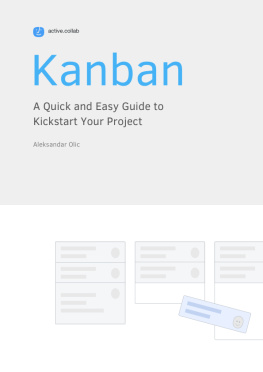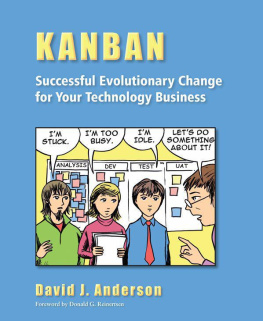Sweny M. Sukumaran
Utkarsha S. Kadam
About the Authors
Tomas Bjrkholm works as a consultant at Crisp in Sweden. Since 2008, he has been helping companies implement and succeed with Kanban and Scrum. He is also a frequently hired speaker and has held more than 150 classes about Agile and Lean for software development. This is Tomas' second book but the first in English.
Jannika Bjrkholm is the team manager of a developer team, and has been working with Agile methods since 2009.
We wish to thank Anna Sandell, Johan Burn, Peter Kerschbaumer, and Mattias Skarin.
Preface
It's just an ordinary day at work for Lisa, the project leader. Already, at the parking place outside the office she meets Ted, the marketing manager. In his normal irritating way, he asks for the project status. Lisa answers with the normal "Fine" and doesn't give any more details. After three years of working with Ted, she knows that this is just his way to start a normal conversation, the request for changed requirements. That's exactly what happens today as well, as usual.
"We met some customers yesterday and they were very clear that some changes were absolutely needed", he started.
Lisa knows there was no point in arguing.
"OK", she said, "what kind of changes are we talking about?"
"Nothing big, just some adjustments. I will pass you later today. See you later, got to run."
Before he left her he fired away the phrase she hated:
"You know, we need to be Agile."
She hated that word, "agile". She didn't know what it meant. It was just used by everybody to excuse their bad behaviour.
Lisa felt that the energy from a good night's sleep was running out of her. A good night's sleep was maybe not the right description. She was no longer able to leave her work behind at the office. Instead it followed her home, spinning around in her head and didn't give her enough peace for a good night's sleep.
She knows this was just the beginning and she was right. Even before she reached her desk, the department manager Alice grabbed her.
"Don't forget to send me the report about the delays in the project. I need it by 2:00 p.m."
Lisa felt how her stress level was increasing. When they are delayed she has to spend her time on writing reports to managers about the delay, instead of spending her time with the developers and helping them speed up.
She went to the kitchen to get a cup of coffee. She had to calm down before entering the project area. She didn't want the developers to see how stressed she felt. She totally failed. And there was no help from the developers. The more stressed she felt the more silent and vague they were. No one was able to say when they thought they would be done. They were only complaining about unclear specifications, short deadlines, and scope creep. And she didn't even dare to mention that Ted would, during the day, introduce new changes.
The frustration increased inside of her. She felt torn between managers, business people, and developers.
Is it time for Lisa to give up and quit? No it isn't! It's just time for a process that can handle changes and at the same time is transparent especially when it comes to status and consequences of a late change.
Kanban is a method that can help Lisa create a process that will improve her working day. If you recognize Lisa's situation, this book, Kanban in 30 Days will guide you to a better situation. It will take you through the basics of Kanban, Agile, and Lean. It will also help you reach the advanced levels, not only on a theoretical level but also on a practical level. The format of the book is a 30-day calendar that day by day gives you tools for setting up a Kanban organization that is continuously optimizing your way of working. The book will be handy even if you prefer to implement Kanban principles and practices in a different way or in another timeframe as well.
There are also a lot of tips that will be helpful for the more advanced Kanban users, such as tips about where waste can be found and eliminated and also how to better understand your context and how to improve it.
Make a note
Throughout the book, you will find that we have used different words to mean the same thing. They are as follows:
- A team, development unit, and people involved in a system refers to the people who are working together or separately on features to improve the same product
- A task, story, user story, feature, item, issue, work, or work task refers to the work the team is doing
















